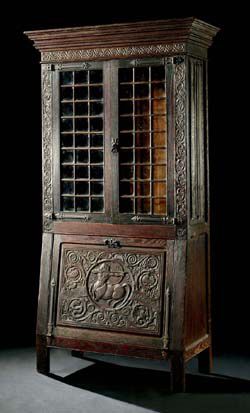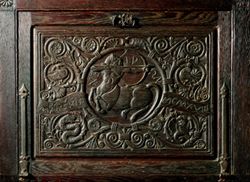The 1918 Manship-Lachase Arts & Crafts Liquor Cabinet
December 20, 2006

New York, NY -- A unique Arts and Crafts style liquor cabinet by Paul Manship and Gaston Lachaise was purchased by the Two Red Roses Foundation at Sotheby's American Renaissance sale on December 15, 2006.
Best known for the golden Prometheus figure at Rockefeller Center, Paul Manship is considered one of the greatest sculptors of the Twentieth Century. While engaged on several significant sculpture commissions, Manship extended his boundless creative energy to the decorations and furnishings of his home. The liquor cabinet is one of the two known case pieces, along with a set of armchairs, which were designed by Paul Manship for his personal use and which have remained in the Manship Family. The cabinet is the only one of these works that is signed "Paul Manship".
In 1918, when this cabinet was created, Gaston Lachaise, who was already an accomplished sculptor, was working as Manship's principal studio assistant because he needed a steady income to support his new wife. At this time, Lachaise was carving Manship's limestone memorial relief to John Pierpont Morgan for the Metropolitan Museum. Lachaise carved Manship's designs onto this cabinet which master carpenter Luigi D'Olivio had constructed. This impressive statement is richly enhanced by Lachaise's masterful carving. Lachaise had learned to carve in France from his father Jean, who was a master cabinetmaker and wood carver. The floral and animal decorations that cover the cabinet's surface demonstrate how the combined talents of two great artists can create a work that surpasses anything they might have achieved alone.
Adapting old-world elegance to suit his modern lifestyle, Manship reinterpreted a traditional form for contemporary entertaining. The ogee-molded cornice adds to its monumental scale as the exposed wrought-iron strap hinges and ornamental locks impart a nostalgic air. The canted fall front case opens down to generously expose the various libations available for festive occasions or the evening's entertainment. This bold arts-and-crafts-style cabinet was doubtless the natural center of interest at the memorable parties hosted by the prosperous young couple, Paul and Isabel Manship in their New York carriage house residence at Washington Mews off Washington Square and later at Seventy-second Street. Manship and his wife were skilled networkers and used these weekly gatherings to promote what was one of the most productive and financially successful fine arts careers of the Twentieth Century.

Executed at the height of Manship's aesthetic powers, the decorations on this cabinet reveal his signature archaizing style and the beautiful, rhythmic line that has been celebrated in his sculpture for anticipating art deco. This same subject matter also shows up in the sculpture that soon followed.
The central emblem on the liquor cabinet represents the noblest of centaurs, Chiron, who gave up his immortality for the betterment of mankind and became the constellation Sagittarius. According to his son John, Paul was known for his merrymaking and his preference for bourbon, Chianti, and Havana cigars - perhaps Manship identified with Chiron who had become the last remaining centaur when all the other centaurs partied themselves into extinction. This liquor cabinet will join the extensive collection of cabinet cases of the two Red Roses Foundation and will provide a striking juxtaposition to other works by Gustav Stickley, Charles Rohlfs and the Byrdcliffe Art Colony.